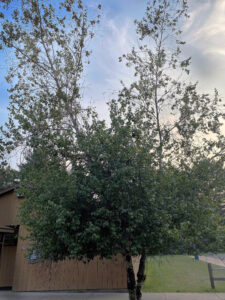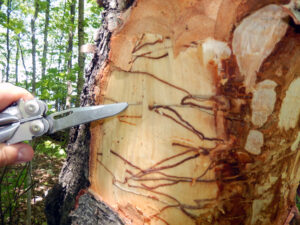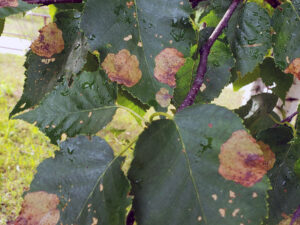By Linda Williams, DNR Forest Health Specialist, Woodruff;
Linda.Williams@wisconsin.gov or 920-360-0665

Bronze birch borer has attacked these trees, and parts of the tree above the attack site are thin and declining. / Photo Credit: Linda Williams, Wisconsin DNR
Bronze birch borer (Agrilus anxius) is a native beetle that attacks birch trees. As adults emerge from the bark, they create small, D-shaped exit holes, similar to emerald ash borer but smaller.
Bronze birch borer attacks stressed trees, and the source of the stress can be anything from drought, flooding, defoliation or old age.
Different species of birch have different life expectancies, with paper birch (white birch) considered mature at 60 to 80 years old. Trees that are older than that may have some stress just due to old age. The paper birch chapter of the Wisconsin DNR Silviculture Guide states that “stand deterioration generally occurs sometime between 70 and 120 years.”
All birch species can be attacked by bronze birch borer, although in Wisconsin the primary targeted species are white birch and any ornamental varieties that have white bark. Trees typically die from the top down and may take 1-3 years to be fully killed. Birch trees will attempt to grow callus tissue over any borers attacking the tree. A healthy tree can stop a borer from getting too far, but a stressed tree will not be able to keep up with the borers, which will eventually girdle the portion of the tree they’re attacking.
Bronze birch borer larvae take one or two years to develop, depending on tree health and how far north they are. Adults are present for most of the summer, although each adult only lives about a month.
With last year’s dry, droughty conditions, we may see more bronze birch borer activity. Past Wisconsin Forest Health annual reports contain numerous mentions of bronze birch borer activity following drought years.

Peeling the bark of a dying white birch shows the tunnels under the bark created by bronze birch borer larvae. / Photo Credit: Linda Williams, Wisconsin DNR
Following the 1976-77 drought, birch mortality was noted as high for the following three years. By 1980, mortality was slowing but birch leafminer (Fenusa pusilla) and birch skeletonizer (Bucculatrix canadensisella) defoliated birch around the state, putting the trees under significant stress once again.

Birch leafminer creates blotches where it has fed and can put the tree under additional stress. / Photo Credit: Wisconsin DNR
After the 1988-89 drought, there were also notes in the annual reports about heavy birch mortality for the next three years. The stress caused by the 1988-‘89 drought was compounded by significant defoliation by birch leafminer in 1988-‘90.
Keeping trees healthy is the key to avoiding damage or mortality from bronze birch borer. Avoiding stress can be difficult when nature decides a drought is going to happen, but you can monitor the age and health of your trees to be prepared for a salvage harvest if necessary. Pesticides, including systemic insecticides, can be used on ornamental trees to prevent attack and keeping them well watered will reduce stress.
